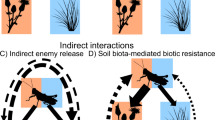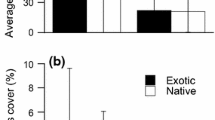Abstract
Herbivores modify various ecological processes including interactions between native and exotic plants that may affect invasion success by the exotic plants. It is unknown whether different types of exotic herbivores have similar effects on native and exotic plants. Using two distinct data sets, we ran meta-analyses to compare exotic vertebrate and invertebrate herbivore preferences for, and effects on performance and population sizes of native and exotic plants. We found that exotic vertebrate herbivores have positive effects on exotic plant performance and population sizes, and no significant effects on native plants. Exotic invertebrates have significant negative effects on performance and population sizes of both exotic and native plants. Vertebrates prefer to feed on native plants relative to exotic plants, while invertebrates prefer the exotic plants to native plants. Thus the exotic vertebrate herbivores may aid invasiveness of exotic plants, in accordance with the invasional meltdown hypothesis, while exotic invertebrate herbivores probably have no net effect on invasion process of the exotic plants. Invertebrate herbivore preferences for exotic plants support the biotic resistance hypothesis, as the native plants probably resist the invertebrate herbivory. We also tested an evolutionary logic that posits that herbivores with similar evolutionary history as plants will affect the plants less negatively than plants with which they have not co-evolved. Our results indicate that there is no consistent pattern in effects of exotic vertebrate and invertebrate herbivores on exotic plants with or without which they have co-evolved.



Similar content being viewed by others
References
Adler PB, Raff DA, Lauenroth WK (2001) The effect of grazing on the spatial heterogeneity of vegetation. Oecologia 128:465–479
Agrawal AA, Kotanen PM (2003) Herbivores and the success of exotic plants: a phylogenetically controlled experiment. Ecology Letters 6:712–715
Baraza E, Zamora R, Hódar JA, Gómez JM (2007) Plant-herbivore interaction. Beyond a binary vision. In: Pugnaire FI, Valladares F (eds) Hand book of functional plant ecology, 2nd edn. CRC Press, Boca Ratón, pp 678–709
Bergelson J (1990) Spatial patterning in plants—opposing effects of herbivory and competition. J Ecol 78:937–948
Best RJ, Arcese P (2009) Exotic herbivores directly facilitate the exotic grasses they graze:mechanisms for an unexpected positive feedback between invaders. Oecologia 159(1):139–150
Bezemer TM, Jones TH (1998) Plant-insect herbivore interactions in elevated atmospheric CO2 quantitative analysis and guild effects. Oikos 82:212–222
Bisigato AJ, Bertiller MB, Ares JO, Pazos GE (2005) Effect of grazing on plant patterns in arid ecosystems of Patagonian Monte. Ecography 28:561–572
Bock CE, Bock JH, Kennedy L, Jones ZF (2007) Spread of non-native grasses into grazed versus ungrazed desert grasslands. J Arid Environ 71:229–235
Branson D, Sword G (2008) Grasshopper herbivory affects native plant diversity and abundance in grassland dominated by the exotic grass Agropyron cristatum. Restor Ecol 17:89–96
Campbell JE, Gibson DJ (2001) The effect of seeds of exotic species transported via horse dung on vegetation along trail corridors. Plant Ecol 157(1):23–25
Colautti RI, Ricciardi A, Grigorovich IA, MacIsaac HJ (2004) Is invasion success affected by enemy release hypothesis? Ecol Lett 7:721–731
Crawley MJ (1989) The relative importance of vertebrate and invertebrate herbivores in plant population dynamics. In: Bernays EA (ed) Insect-plant interactions, vol 1. CRC press, Boca Raton, pp 45–71
Cushman JH, Tierney TA, Hinds JM (2004) Variable effects of feral pig disturbances on native and exotic plants in a California grassland. Ecol Appl 14:1746–1756
Donlan CJ, Tershy BR, Croll DA (2002) Islands and exotic herbivores: conservation action as ecosystem experimentation. J Appl Ecol 39:235–246
Egan J, Irwin R (2008) Evaluation of the field impact of an adventitious herbivore on an invasive plant, yellow toadflax, in Colorado, USA. Plant Ecol 199:99–114
Fischer SF, Poschlod P, Beinlich B (1996) Experimental studies on the dispersal of plants and animals on sheep in calcareous grasslands. J Appl Ecol 33:1206–1222
Focardi S, Tinelli A (2005) Herbivory in a Mediterranean forest: browsing impact and plant compensation. Acta Oecol Int J Ecol 28:239–247
Gill RMA (1992) A review of damage by mammals in north temperate forests.3. Impacts on trees and forests. Forestry 65:363–388
Gordon IJ (1989) Vegetation community selection by ungulates on the Isle of Rhum.III. Determinants of vegetation community selection. J Appl Ecol 26:65–79
Gurevitch J, Hedges LV (1999) Statistical issues in ecological meta-analyses. Ecology 80:1142–1149
Hanley ME, Sykes RJ (2009) Impact of seedling herbivory on plant competition and implications for species co-existence. Ann Bot. doi: 10.1093/aob/mcp081
Hanley ME, Fenner M, Edwards PJ (1996) The effect of mollusk grazing on seedling recruitment in artificially created grassland gaps. Oecologia 106:240–246
Hendrix SD (1990) Herbivory and its impact on plant reproduction. In: Doust JL, Doust LL (eds) Plant reproduction ecology: patterns and strategies, pp 246–259
Holmgren M (2002) Exotic herbivores as drivers of plant invasion and switch to ecosystem alternative states. Biol Invasions 4:25–33
Holmgren M, Avilés R, Sierralta L, Segura AM, Fuentes ER (2000) Why have European herbs so successfully invaded the Chilean matorral? Effects of herbivory, soil nutrients, and fire. J Arid Environ 44:197–211
Hulme PE (1994) Seedling herbivory in grassland: relative impact of vertebrate and invertebrate herbivores. J Ecol 82:873–880
Hulme PE (1996a) Herbivores and the performance of grassland plants: a comparison of arthropod, mollusk and rodent herbivory. J Ecol 84:43–51
Hulme PE (1996b) Herbivory, plant regeneration, and species coexistence. J Ecol 84:609–615
Janz N, Nylin S (1998) Butterflies and plants: a phylogenetic study. Evolution 52(2):486-502
Janzen D (1984) Dispersal of small seeds by big herbivores-foliage is the fruit. Am Nat 123:338–353
Jasmin JN, Rochefort L, Gauthier G (2008) Goose grazing influences the fine-scale structure of a bryophyte community in arctic wetlands. Polar Biol 31:1043–1049
Joe SM, Daehler CC (2008) Invasive slugs as under-appreciated obstacles to rare plant restoration: evidence from the Hawaiian Islands. Biol Invasions 10:245–255
Karban R, Baldwin IT (1997) Induced responses to herbivory. University of Chicago Press, Chicago
Keeley JE, Lubin D, Fotheringham CJ (2003) Fire and grazing impacts on plant diversity and alien plant invasions in the southern Sierra Nevada. Ecol Appl 13(5):1355–1374
Levine JM, Adler PB, Yelenik SG (2004) A meta-analysis of biotic resistance to exotic plant invasions. Ecol Lett 7:975–989
Loeser MRR, Sisk TD, Crews TE (2007) Impact of grazing intensity during drought in an Arizona grassland. Conserv Biol 21(1):87–97
Louda SM, Kendall D, Connor J, Simberloff D (1997) Ecological effects of an insect introduced for the biological control of weeds. Science 277:1088–1090
Louda SM, Arnett AE, Rand TA, Russell FL (2003) Invasiveness of some biological control insects and adequacy of their ecological risk assessment and regulation. Conserv Biol 17:73–82
Loydi A, Zalba SM (2008) Feral horses dung piles as potential invasion windows for alien plant species in natural grasslands. Plant Ecol 201:471–480
Malo JE, Suarez F (1995) Herbivorous mammals as seed dispersers in a Mediterranean Dehesa. Oecologia 104:246–255
Malo JE, Suarez F (1997) Dispersal mechanism and transcontinental naturalization proneness among Mediterranean herbaceous species. J Biogeogr 24:391–394
Manrique R, Gutiérrez JR, Holmgren M, Squeo FA (2007) Reduced herbivory during simulated ENSO rainy events increases native herbaceous plants in semiarid Chile. Plant Ecol 191:21–31
Manzano P, Malo JE (2006) Extreme long-distance seed dispersal via sheep. Front Ecol Environ 4:244–248
Maron JL, Crone E (2006) Herbivory: effects on plant abundance, distribution and population growth. Proc R Soc B 273:2575–2584
Maron JL, Vilá M (2001) When do herbivores affect plant invasion? Evidence for the natural enemies and biotic resistance hypotheses. Oikos 95:361–373
Mouissie M (2004) Seed dispersal by large herbivores: implications for the restoration of plant biodiversity. Ph.D. dissertation, Groningen University, The Netherlands
Myers JA, Vellend M, Gardescu S, Marks PL (2004) Seed dispersal by white-tailed deer: implications for long-distance dispersal, invasion, and migration of plants in eastern North America. Oecologia 139:35–44
Nuñez MA, Relva MA, Simberloff D (2008) Enemy release or invasional meltdown? Deer preference for exotic and native trees on Isla Victoria, Argentina. Austral Ecol 33:317–323
Pakeman RJ (2001) Plant migration rates and seed dispersal mechanisms. J Biogeogr 28:795–800
Pakeman RJ, Digneffe G, Small JL (2002) Ecological correlates of endozoochory by herbivores. Funct Ecol 16:296–304
Palmisano S, Fox LR (1997) Effects of mammal and insect herbivory on population dynamics of a native California thistle, Cirsium occidentale. Oecologia 111:413–421
Parker JD, Deron E, Burkepile DE, Hay ME (2006) Opposing effects of native and exotic herbivores on plant invasions. Science 311:1459–1461
Rosenberg MS, Dean CA, Gurevitch J (2000) Meta win-statistical software for meta-analysis. Version 2.0. Sinauer Associates Inc, Massachusetts
Rosenthal R (1979) The ‘file drawer’ problem and tolerance for null results. Psychol Bull 86:638–641
Rosenthal JP, Dirzo R (1997) Effects of life history, domestication and agronomic selection on plant defence against insects: evidence from maizes and wild relatives. Evol Ecol 11:337–355
Schoonhoven LM, van Loon JJA, Dicke M (2005) Insect-plant biology, 2nd edn. Oxford University Press, Oxford, p 421
Sessions LA, Kelly D (2001) Heterogeneity in vertebrate and invertebrate herbivory and its consequences for New Zealand mistletoes. Austral Ecol 26:571–581
Simberloff D (2006) Invasional meltdown 6 years later: important phenomenon, unfortunate metaphor, or both? Ecol Lett 9:912–919
Stohlgren TJ, Schell LD, Vanden Heuvel B (1999) How grazing and soil quality affect native and exotic plant diversity in rocky mountain grasslands. Ecol Appl 9:45–64
Strauss SY (1991) Direct, indirect, and cumulative effects of three native herbivores on a shared host plant. Ecology 72:543–558
Strauss SY, Stanton ML, Emery NC, Bradley CR, Dittrich-Reed DR, Ervin OA, Gray LN, Hamilton AM, Harper SD, Law KN, Pham VQ, Putnam ME, Roth TM, Wells LM, Yoshizuka EM (2009) Cryptic predation by invertebrate nocturnal generalists may underlie survival, performance and fine-scale distribution of native and exotic plants. Ecology 90(2):419–429
Tierney TA, Cushman JH (2006) Temporal changes in native and exotic vegetation and soil characteristics following disturbances by feral pigs in a California grassland. Biol Invasions 8:1073–1089
Vázquez DP (2002) Multiple effects of introduced mammalian herbivores in a temperate forest. Biol Invasions 4:175–191
Veen GF, Blair JM, Smith MD, Collins SL (2008) Influence of grazing and fire frequency on small-scale plant community structure and resource variability in native tallgrass prairie. Oikos 117:859–866
Vellend M, Myers JA, Gardescu S, Marks PL (2003) Dispersal of Trillium seeds by deer: Implications for long-distance migration of forest herbs. Ecology 84:1067–1072
Waldbauer G (2003) What good are bugs? Insects in the web of life. Harvard University press, Cambridge, p 366
Yates CJ, Norton DA, Hobbs RJ (2000) Grazing effects on plant cover, soil and microclimate in fragmented woodlands in south-western Australia: implications for restoration. Austral Ecol 25:36–47
Acknowledgments
We thank Martín A. Nuñez for inviting us to write this review and Kimberly J. Komatsu for providing unpublished data. Lyn A. Gettys provided published data that were otherwise inaccessible to us. A grant from the foundation Banco Bilbao Vizcaya Argentaria (BBVA-BIOCON06/064) partly supported this study.
Author information
Authors and Affiliations
Corresponding author
Electronic supplementary material
Rights and permissions
About this article
Cite this article
Oduor, A.M.O., Gómez, J.M. & Strauss, S.Y. Exotic vertebrate and invertebrate herbivores differ in their impacts on native and exotic plants: a meta-analysis. Biol Invasions 12, 407–419 (2010). https://doi.org/10.1007/s10530-009-9622-1
Received:
Accepted:
Published:
Issue Date:
DOI: https://doi.org/10.1007/s10530-009-9622-1




